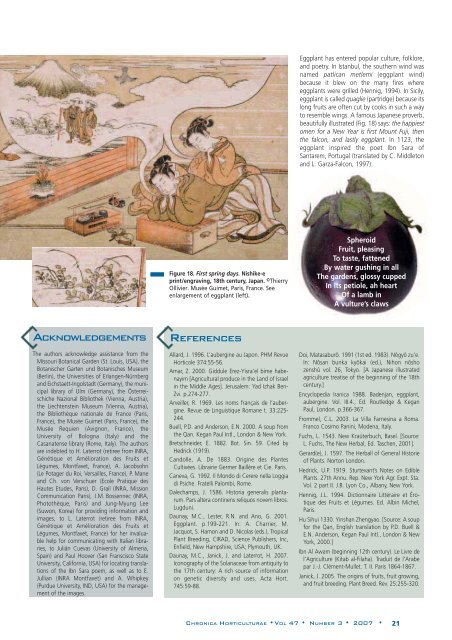Chronica - Acta Horticulturae
Chronica - Acta Horticulturae
Chronica - Acta Horticulturae
You also want an ePaper? Increase the reach of your titles
YUMPU automatically turns print PDFs into web optimized ePapers that Google loves.
Eggplant has entered popular culture, folklore,<br />
and poetry. In Istanbul, the southern wind was<br />
named patlican metlemi (eggplant wind)<br />
because it blew on the many fires where<br />
eggplants were grilled (Hennig, 1994). In Sicily,<br />
eggplant is called quaglie (partridge) because its<br />
long fruits are often cut by cooks in such a way<br />
to resemble wings. A famous Japanese proverb,<br />
beautifully illustrated (Fig. 18) says: the happiest<br />
omen for a New Year is first Mount Fuji, then<br />
the falcon, and lastly eggplant. In 1123, the<br />
eggplant inspired the poet Ibn Sara of<br />
Santarem, Portugal (translated by C. Middleton<br />
and L. Garza-Falcon, 1997):<br />
Figure 18. First spring days. Nishike-e<br />
print/engraving, 18th century, Japan. © Thierry<br />
Ollivier. Musée Guimet, Paris, France. See<br />
enlargement of eggplant (left).<br />
Spheroid<br />
Fruit, pleasing<br />
To taste, fattened<br />
By water gushing in all<br />
The gardens, glossy cupped<br />
In its petiole, ah heart<br />
Of a lamb in<br />
A vulture’s claws<br />
ACKNOWLEDGEMENTS<br />
The authors acknowledge assistance from the<br />
Missouri Botanical Garden (St. Louis, USA), the<br />
Botanischer Garten und Botanisches Museum<br />
(Berlin), the Universities of Erlangen-Nürnberg<br />
and Eichstaett-Ingolstadt (Germany), the municipal<br />
library of Ulm (Germany), the Österreischiche<br />
Nazional Bibliothek (Vienna, Austria),<br />
the Liechtenstein Museum (Vienna, Austria),<br />
the Bibliothèque nationale de France (Paris,<br />
France), the Musée Guimet (Paris, France), the<br />
Musée Requien (Avignon, France), the<br />
University of Bologna (Italy) and the<br />
Casanatense library (Rome, Italy). The authors<br />
are indebted to H. Laterrot (retiree from INRA,<br />
Génétique et Amélioration des Fruits et<br />
Légumes, Montfavet, France), A. Jacobsohn<br />
(Le Potager du Roi, Versailles, France), P. Mane<br />
and Ch. von Verschuer (Ecole Pratique des<br />
Hautes Etudes, Paris), D. Grail (INRA, Mission<br />
Communication Paris), J.M. Bossennec (INRA,<br />
Photothèque, Paris) and Jung-Myung Lee<br />
(Suwon, Korea) for providing information and<br />
images, to L. Laterrot (retiree from INRA,<br />
Génétique et Amélioration des Fruits et<br />
Légumes, Montfavet, France) for her invaluable<br />
help for communicating with Italian libraries,<br />
to Julián Cuevas (University of Almeria,<br />
Spain) and Paul Hoover (San Franscisco State<br />
University, California, USA) for locating translations<br />
of the Ibn Sara poem, as well as to E.<br />
Jullian (INRA Montfavet) and A. Whipkey<br />
(Purdue University, IND, USA) for the management<br />
of the images.<br />
REFERENCES<br />
Allard, J. 1996. L’aubergine au Japon. PHM Revue<br />
Horticole 374:55-56.<br />
Amar, Z. 2000. Giddule Erez-Yisra’el bime habenayim<br />
[Agricultural produce in the Land of Israel<br />
in the Middle Ages]. Jerusalem: Yad Izhak Ben-<br />
Zvi. p.274-277.<br />
Arveiller, R. 1969. Les noms français de l’aubergine.<br />
Revue de Linguistique Romane t. 33:225-<br />
244.<br />
Buell, P.D. and Anderson, E.N. 2000. A soup from<br />
the Qan. Kegan Paul Intl., London & New York.<br />
Bretschneider, E. 1882. Bot. Sin. 59. Cited by<br />
Hedrick (1919).<br />
Candolle, A. De 1883. Origine des Plantes<br />
Cultivées. Librairie Germer Baillère et Cie. Paris.<br />
Caneva, G. 1992. Il Mondo di Cerere nella Loggia<br />
di Psiche. Fratelli Palombi, Rome.<br />
Dalechamps, J. 1586. Historia generalis plantarum.<br />
Pars altera continens reliquos novem libros.<br />
Lugduni.<br />
Daunay, M.C., Lester, R.N. and Ano, G. 2001.<br />
Eggplant. p.199-221. In: A. Charrier, M.<br />
Jacquot, S. Hamon and D. Nicolas (eds.), Tropical<br />
Plant Breeding, CIRAD, Science Publishers, Inc,<br />
Enfield, New Hampshire, USA; Plymouth, UK.<br />
Daunay, M.C., Janick, J. and Laterrot, H. 2007.<br />
Iconography of the Solanaceae from antiquity to<br />
the 17th century: A rich source of information<br />
on genetic diversity and uses. <strong>Acta</strong> Hort.<br />
745:59-88.<br />
Doi, Matasaburô. 1991 (1st ed. 1983). Nôgyô zu’e.<br />
In: Nôsan bunka kyôkai (ed.), Nihon nôsho<br />
zenshû vol. 26, Tokyo. [A Japanese illustrated<br />
agriculture treatise of the beginning of the 18th<br />
century.]<br />
Encyclopedia Iranica 1988. Badenjan, eggplant,<br />
aubergine. Vol. III.4., Ed. Routledge & Kegan<br />
Paul, London. p.366-367.<br />
Frommel, C.L. 2003. La Villa Farnesina a Roma.<br />
Franco Cosimo Panini, Modena, Italy.<br />
Fuchs, L. 1543. New Kraüterbuch, Basel. [Source:<br />
L. Fuchs, The New Herbal, Ed. Taschen, 2001].<br />
Gerard(e), J. 1597. The Herball of General Historie<br />
of Plants. Norton London.<br />
Hedrick, U.P. 1919. Sturtevant’s Notes on Edible<br />
Plants. 27th Annu. Rep. New York Agr. Expt. Sta.<br />
Vol. 2 part II. J.B. Lyon Co., Albany, New York.<br />
Hennig, J.L. 1994. Dictionnaire Littéraire et Érotique<br />
des Fruits et Légumes. Ed. Albin Michel,<br />
Paris.<br />
Hu Sihui 1330. Yinshan Zhengyao. [Source: A soup<br />
for the Qan, English translation by P.D. Buell &<br />
E.N. Anderson, Kegan Paul Intl., London & New<br />
York, 2000.]<br />
Ibn Al Awam (beginning 12th century). Le Livre de<br />
l’Agriculture (Kitab al-Filaha). Traduit de l’Arabe<br />
par J.-J. Clément-Mullet. T. II. Paris 1864-1867.<br />
Janick, J. 2005. The origins of fruits, fruit growing,<br />
and fruit breeding. Plant Breed. Rev. 25:255-320.<br />
CHRONICA HORTICULTURAE •VOL 47 • NUMBER 3 • 2007 • 21
















